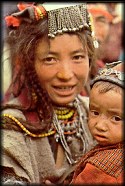  |  |
|
  |  |
|
The Indian Government, with its various schemes, caters to all the citizens of India irrespective of their caste, creed, gender, age and geographical origin. Children, often referred to as the leaders of tomorrow, are taken due care of by the government by various means and measures.
 According to Article 39 of the Directive Principles of State Policy, the Constitution of India pledges that the State will direct its policy towards children, with an aim of providing them the opportunities and facilities to grow in a healthy manner, in conditions of freedom and dignity, and to protect them from exploitation. According to Article 39 of the Directive Principles of State Policy, the Constitution of India pledges that the State will direct its policy towards children, with an aim of providing them the opportunities and facilities to grow in a healthy manner, in conditions of freedom and dignity, and to protect them from exploitation.
Child welfare programmes have occupied a prominent place in the national plans of the human resource development of the government. In this regard, India has adopted the National Policy on Children in 1974. It is aimed at ensuring equality of opportunity to the children. The policy provides the framework to address the needs of the children.  India is a signatory to the World Declaration on the Survival, Protection and Development of Children. In pursuance of its commitment, the Department of Women and Child Development, has formulated the National Plan of Action for Children. The areas addressed by the plan include health, nutrition, education, water, sanitation and environment. The nation has also addressed the polio disease by providing free vaccination camps for children to be vaccinated against polio India is a signatory to the World Declaration on the Survival, Protection and Development of Children. In pursuance of its commitment, the Department of Women and Child Development, has formulated the National Plan of Action for Children. The areas addressed by the plan include health, nutrition, education, water, sanitation and environment. The nation has also addressed the polio disease by providing free vaccination camps for children to be vaccinated against polio
The female child is often treated as the source of prosperity of the house. However, there have been cases where the female child has been considered a burden by her parents. To ensure that the female child is no longer discriminated, the government has been campaigning effectively. The slogan of the Indian government to caimpaign for the Girl Child has been A Happy Girl is the Future of our Country. The National Plan of Action for the Girl Child, seeks to prevent female foeticide and infanticide, to eliminate discrimination based on gender, rehabilitate and protect girls from exploitation, assault and abuse.  The Education for All campaign of the government addresses 19 to 24 million children in the age group 6 to 14, of which 60 percent are girls. Apart from these activities, numerous Non-Governmental Organizations in India are providing means to provide shelter, better health, education and training to the street children, thereby rehabilitating them. The Education for All campaign of the government addresses 19 to 24 million children in the age group 6 to 14, of which 60 percent are girls. Apart from these activities, numerous Non-Governmental Organizations in India are providing means to provide shelter, better health, education and training to the street children, thereby rehabilitating them.
India's stand on child labour has evolved over years. The Child Labour Prohibition and Regulation Act of the government aims at banning employment of children below the age of fourteen years in factories, mines and hazardous employment. |
| About India | Arts | Cuisine | Fairs | Festivals | Neighbours | Society | Religions |
| Site Map | Disclaimer | About Us | Write To Us |